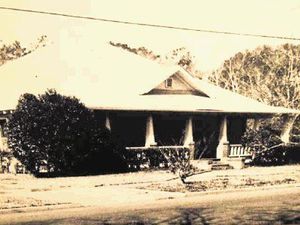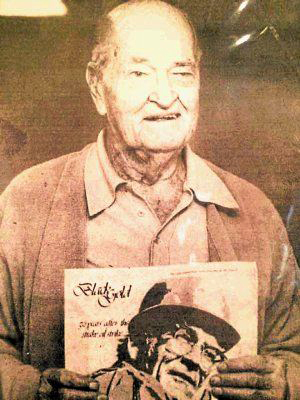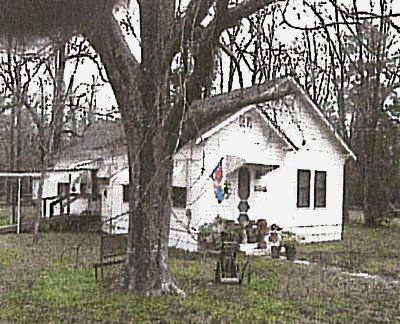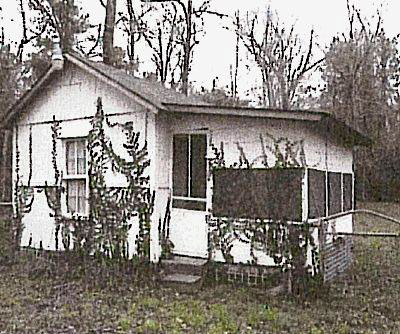Courtesy The Heritage Museum of Montgomery County
The Cochran Home when it was on the corner of Thompson and Nugent street north of downtown Conroe. The home was moved to Candy Cane Park in 1985 and now serves at the Heritage Museum of Montgomery County.
The entity that houses Montgomery County’s most treasured history and artifacts is marking a milestone itself today.
On this day, 30 years ago, the Heritage Museum of Montgomery County was established to share the history of the area with residents and visitors alike.
The county boasts a rich history dating back the 1800s and is very much a part of state history as well, with the designer of the Texas flag, Dr. Charles B. Stewart residing in the historic town of Montgomery and taking part in the state’s formation. Sam Houston spent time in Montgomery as well and in the early 1930s, George Strake put Conroe on the map by discovering oil in the southeast quadrant of the county.
And in the mid-1980s, some long-time residents of Montgomery County thought it was about time that the county’s history was celebrated and put on display.
Historian Gertie Spencer was on the board of the Chamber of Commerce in 1984, and several of the chamber members wondered why Montgomery County didn’t have its own history museum.
Spencer, along with Steven McClain, Willie Whitehead and several others, formed a committee and set out to investigate the possibility of forming a museum.
Spencer and the other members presented the idea to area organizations to see what people thought.
“We found a savior in the Conroe Service League,” Spencer said.
The members of the ladies service organization took up the cause for the museum quite passionately and along with Spencer and others on the museum committee, they traveled the state in small groups looking at what other Texas towns had done.
A fundraising gala was held by the Service League that brought in $60,000 for the formation of the museum. The Montgomery County Historical Commission donated a sizeable amount to get the museum off its feet as well.
With the funds raised, then there was the issue of where would they house this museum and where would it go?
Planners had their hearts set on the old Train Depot next to the tracks at Pacific Ave. and First Street. Then tragedy struck when it burned beyond repair in the mid-1980s.
“When the depot burned, that really took the wind out of our sails,” Spencer said.
But, soon after, Carolyn, Andy and Andrew Walker donated “The Cochran Home” for use as the Heritage Museum.
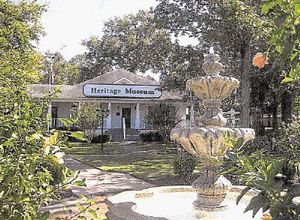
Courtesy The Heritage Museum of Montgomery
County
The Heritage Museum as it looks
today in
Candy Cane Park(2015)
The house was built by J. G. Grogan Sr. for his family in 1924. However, his first wife died soon after and he moved his family to Magnolia. The home was sold several times through family ties eventually being purchased by Virgil and Lucille Taylor Cochran making it “The Cochran Home.”
Their eight children and 22 grandchildren have memories of playing, swinging or sitting on the front porch and watching parades go by on Thompson street. The home’s original location was on the corner of Thompson and Nugent streets. Many weddings, funerals, arrivals of babies and holiday dinners were celebrated in the home.
Carolyn Meadows Walker, the great-granddaughter of Laura Grogan and Terrell Mack Cochran was the final owner of the home and lived there for 10 years with her family, Andy and Andrew Walker, before donating the house to the museum.
The next problem was how to get the house to the property in Candy Cane Park that the city had donated.
The moving job was taken on by Floyd Baker, who was the go-to house mover in town at the time.
JoCarol Oberman, past president of the Heritage Museum Board, recalls the moving of the house took place in the fall of 1985 and took the better part of a day.
The home was split in two to be moved and the highest part of the roof was taken off.
Oberman remembered it was quite a spectacle that day in town as roads had to be closed and power lines lifted.
She brought her young sons out to see the event.
Once the home was in place, it took much updating to bring the residential home up to code as a commercial venue.
Oberman said it was a labor of love for the ladies of the service league.
“There wasn’t a time when you couldn’t find volunteers or board members or service league members working on the house,” Spencer said.
While the grand opening for the museum was held in May 1986, filling the museum took a little while.
At first they had traveling exhibits and the first permanent exhibit was put together by Elva Wilson and Mary Spencer.
It was a replica of Dr. Charles B. Stewart’s office.
Eventually the museum was filled with 95 percent of the artifacts and documents coming from local families, according to Spencer.
Morris Bateman, a longtime employee of the telephone company donated a old-fashioned switchboard, the Gentry family donated a case of artifacts and important documents came from an unexpected donation from the Griffin Abstract collection. One early document had a signature from Stephen F. Austin.
At its 30th anniversary mark, the museum is filled to the brim with pieces of county history, which will lead to the next phase of expansion for the facility.
Strake-Gray Oilfield House and Roughneck House
Perhaps one of the most important things to ever happen to Montgomery County and the Conroe area was Strake’s discovery of oil in December 1931.
While much of the nation was in the grips of The Great Depression, Conroe was a place of prosperity and became an instant boom town. It’s said the population grew from 3,000 to approximately 15,000 in a matter of weeks.
Sarah Bess Gray Crow’s family is one of the families whose lives were changed by the oil boom.
Courtesy The Heritage Museum of
Montgomery County
Clyde Thomas "Dolly" Gray is pictured in The Courier on the 50th anniversary of the discovery of oil. Gray is a legendary figure of Montgomery County and was a foreman in George Strake’s oilfield.
Her father, Clyde Thomas "Dolly" Gray, was an excellent baseball player, and he came to Conroe looking for work in the oil fields.
Back then all the oil companies had company baseball teams - including Strake. His was the Strake Wildcats.
“Dolly” Gray was asked to fill in for one game and he hit a home run, according to his daughter Sarah Bess.
“Back then they’d pass the hat after the games,” she said. “When it got to my dad, there was a note in it from Mr. Strake that said ‘Report for work in the morning.’”
Gray was a roustabout in the oil field and in 1946 became foreman of the Strake field.
The Gray family moved from town to the house that Strake had purchased previously for former head driller Harvey Lee. It was on Duffy Lane and across from the Strake Oil field Warehouse about seven miles from Conroe.
“The home was a Sears & Roebuck Craftsman home that Mr. Strake purchased and had shipped to Conroe,” said Butch Bateman, president of the Heritage Museum Board. “It was put together piece by piece in Conroe. If you go up in the attic, you won’t find a crooked board or knot in the wood.”
That’s how well the home was crafted.
Courtesy The Heritage Museum of Montgomery County
The Strake-Gray Oilfield House that will soon move to the Heritage Museum Complex. It’s currently on Duffy Lane southeast of Conroe
It was the house Gray-Crow moved to when she was four and she has many fond memories of her swing set that was made of pipe from the oil field, going to fetch salt tabs from the warehouse across the street and the big trucks that would drive up and down the dirt roads.
Courtesy The Heritage Museum of Montgomery County
The Roughneck House on the Gray property will also move to the Heritage Museum complex along with the Strake-Gray Oilfield House. Oil field workers used the bunkhouse as a place to sleep before returning to the field
Behind the main house, is a “Roughneck House.” Men would come from Houston to work in the oil fields and they’d sleep and eat in the bunkhouse and head back to work while their families remained in Houston.
By the time Gray-Crow moved there, it was mainly used for storage of baseball equipment.
Her father’s reputation for playing baseball was legendary and he was the voice of Conroe Little League and did much for the baseball community. He played baseball well into his 60s.
“Dolly” Gray passed away in 2003 and now Gray-Crow is donating the two structures on her parents land to the Heritage Museum.
Members of the Heritage Museum Board are currently making arrangements for the structures to be moved from southeast of Conroe to Candy Cane Park. They hope to have the structures in place by the end of the year.
They will reside next to the current Heritage Museum and exhibits in the structures will help tell the story of oil’s impact on the county and the baseball teams from the oil camps. It will also add additional space for the overflowing museum.
“I couldn’t have lived with a more famous person in Montgomery County,” said Gray-Crow. “Everyone knew about my dad. It was a nice way to grow up.”
Anyone interested in donating to the museum or becoming a Friend of the Heritage Museum may contact 936-539-MUSE (6873).
Heritage Museum of Montgomery
County
Location: 1506 I-45 North Feeder (inside
Candy Cane Park), Conroe
Phone: 936-539-MUSE (6873)
Hours: Open 9 a.m. to 4 p.m. Wednesday
through Saturday, closed on holidays
Suggested donation: $1 for adults, 50
cents for children
Web page: heritagemuseum.us
Features of the Heritage Museum
Gallery 1 - 5,000 BC to the present - A
timeline of Montgomery County history including
many historic photos of the area, artifacts and
documents.
Gallery 2 - Towns, People and Events -
Live-sized figures of key figures in Montgomery
County’s history, like Isaac Conroe and George
Strake.
Gallery 3 - General Store and Log Cabin -
A children’s hands-on area.
Mark Clapham Gallery - Noted Western
artist Mark Clapham donated a large portion of
his artwork to the Museum following his death in
January 2012. Sculpture, paintings and some
jewelry are featured in the gallery.
Gift shop - The museum gift shop has a
variety of Texas gift items for purchase, along
with various craft items made by members of the
Heritage Museum of Montgomery County board and a
selection of books written by local authors
about the area.
Pioneer Days - For boys and girls eight
to 11, the week-long program offers children a
look at pioneer “chores” like dipping candles,
sawing logs, churning butter, piecing a quilt
and more. The program begins the Monday after
July 4. Registration opens in May.
Video History Project - DVDs of Montgomery
County’s long-time residents “telling how it
used to be” are available for $15 at the
Heritage Museum.

